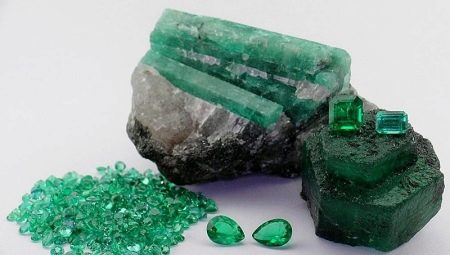In the field of jewelry manufacturing, emeralds are in great demand. This is one of the most expensive stones that attract attention with an enchanting green color. Due to the high cost and popularity of the stone, there is a risk of spending money on a fake. Modern technology allows you to create high-quality simulations that are very difficult to distinguish from real stones. The article will discuss how to distinguish a natural emerald from an artificial crystal, and is it possible to do this at home. We also find out which analogues can be found and sold.
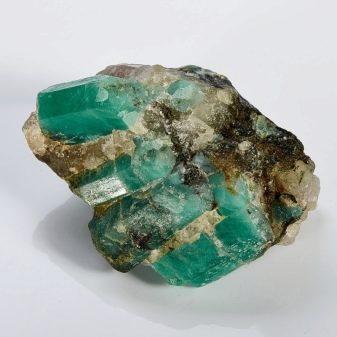
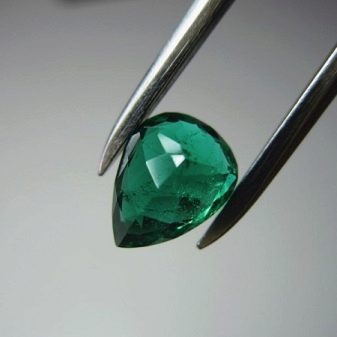
Stone description
The most valuable natural emeralds can boast of high transparency. Turbid stones are more accessible and more common. Many specimens have interspersed gas, liquids, and other minerals that make emeralds opaque. To maximize the beauty of the stone, before engraving and selling it is treated with special chemical compounds. What sways colors, in nature there are emeralds of various colors.
The color ranges from yellow-green to green with a blue tint. The main color is green, including a dark and saturated tone.

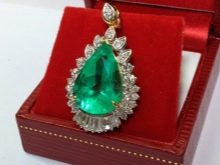
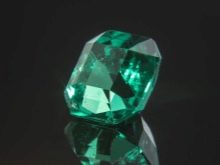
Professional analysis
Verifying the authenticity of a natural gem is very difficult, however, methods are available. The most reliable option is to seek the help of a professional expert. The method of checking with ultraviolet radiation is very popular, but even it does not always give the necessary result. This method helps to determine the authenticity of the stone, distinguishing it from glass and other imitations.It is worth noting that artificially created and natural gems during transmission can have the same color.
The Chelsea filter is another method that experts use to recognize a fake. It is not suitable for home use. With it, you can determine the synthetic product, but against some types of artificial stones, it is useless. On the basis of specially equipped complexes, gems are checked according to the following characteristics:
- structure;
- impurities;
- refraction of light;
- hardness;
- other parameters.
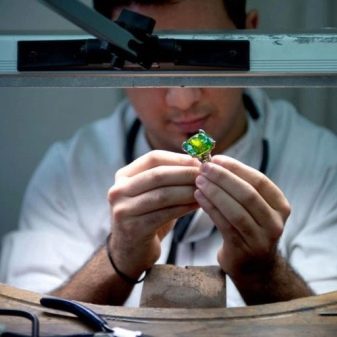

Centuries ago, in order to distinguish natural stone from fake, they were weighed. Now this verification method is also found. Special scales for jewelry are used. It is worth noting that special equipment is used to conduct the analysis.
Also, do not do without knowledge and skills. Experts say that in some cases, natural inclusions are confused with ordinary air bubbles. By the appearance of turbidity and bubbles, the specialist is able to determine where the gem was mined, what material was used to simulate. A faceted emerald is inspected at a distance of about 2 meters. Natural mineral slightly shimmers at such a distance.
Natural stones have the appropriate certificates issued by employees of gemological laboratories. They confirm the natural origin of the gem.
It is advisable to check these documents before purchasing a stone.
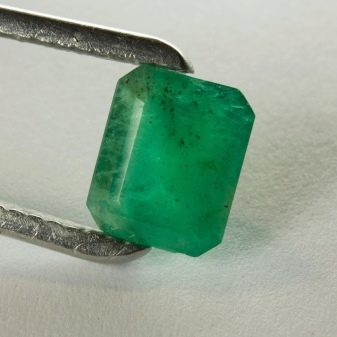
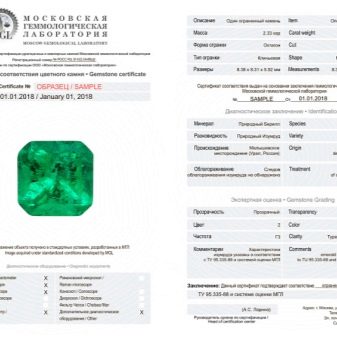
Ways to determine the nature of the stone
There are a number of techniques that everyone can use to determine the nature of the origin of the gem. To find out the naturalness of the crystal, use the following recommendations.
- Trademark. Before heading to the jewelry store, it is advisable to familiarize yourself with reliable and trusted brands. By purchasing products of famous brands, you increase the chances of buying high-quality goods.
- Water. Immerse the natural gem in a glass of clean water. Natural gems often acquire a red tint.
- Glass. Glass imitations are too large, and their edges are fuzzy. Another characteristic of a copy of this material is that it quickly heats up in the hands.
- Layers. Natural stones obtained in natural conditions do not possess layering. In this connection, gems must be carefully examined. The work is carried out in full light. The bonding place indicates that you have a doublet or triplet. Bubbles indicate that one of the fake layers is glass.
- Synthetics. Synthetic gems can be distinguished by the correct lines of growth and smooth, parallel faces. Natural specimens do not have such a well-coordinated geometry.
- External features. An overly transparent stone indicates that you have an artificial gem or a copy of glass. For such products, liquid inclusions are not uncommon. Natural materials of medium quality have blackouts, as well as elements such as scuffs. Such imperfections are called Jardin.
- Color. The ideal color to attract the attention of a potential buyer may indicate a fake. Fakes also have an excessively smooth surface. Natural gems can often be interspersed with the following colors: blue, brown and yellow. The edges of the raw material are lighter than the core.
- Radiance. Gems of natural origin have a mild dispersion (play of light). Cheaper gems, such as zirconium, have a bright sparkle.
- Cost. Real stone cannot be cheap. For the price of some specimens are not inferior to diamonds. It is also recommended that you make a purchase at a trusted jewelry store.



Common fakes and imitations
Instead of natural gems, the following items are offered:
- doublets and triplets;
- fakes made of glass;
- artificial stones;
- imitations.

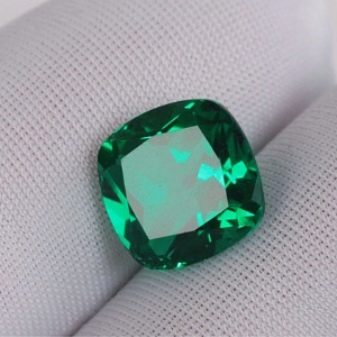
Such options are visually very similar to natural stones, but they are not. The most popular way to trick a gullible customer is to offer a more affordable and widespread gem instead of emerald. There are many crystals, which in appearance and other characteristics are similar to an expensive green stone. Most often, the following options are used:
- tsavorite - a stone called green pomegranate;
- due to the smaller number of special reflective elements in tourmaline, it is not as shiny as natural emerald, however, it is also often used as a replacement;
- fluorite is very difficult to distinguish from natural emerald; in composition, this crystal is very similar to Colombian emerald;
- the demantoid has a grassy green color, green inclusions are often present, after cutting the stone becomes like an emerald.
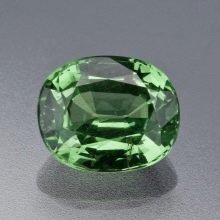

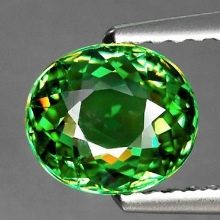
Layered stones
Stones made of two connected parts are called doublets, and of the three - triplets. The first such specimens appeared in the time of Ancient Greece. Several gem plates are securely fastened together using special compositions. Faceted beryl is often used. For a more attractive visual effect, a color pad is added.
In some cases, real emeralds are used to create the simulation. Natural gems of natural origin are combined with other low-quality minerals. The most popular crystals for making doublets and triplets are also quartz, smaragd and spinel. One of the layers may be ordinary glass.

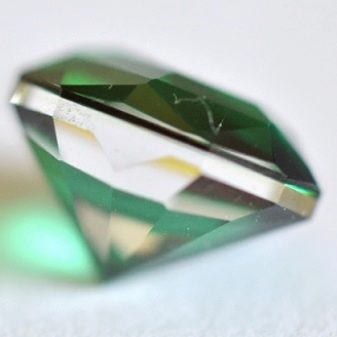
Synthetics
There is evidence that emerald is the second crystal that was grown under laboratory conditions. Great demand was triggered by the high cost of emeralds. A group of specialists worked on the creation of synthetic stone, so it is now almost impossible to determine the name of the scientist who made the copy. Some sources indicate that the first synthetically emerald appeared in Germany, around the 30s of the last century. After this, successes in this direction were achieved by specialists from America and the USSR.
Currently, through the development of technology, the process of creating crystals has become easier, but is still considered time-consuming and lengthy. It is impossible to grow a gem without special equipment and knowledge. Modern fakes are distinguished by beauty and other characteristics. High-quality fakes attract attention at a low price, rich color and expressive play of light.
In jewelry stores, such products are not uncommon, however, sellers are obliged to warn the buyer that they have a synthetic emerald in front of him.
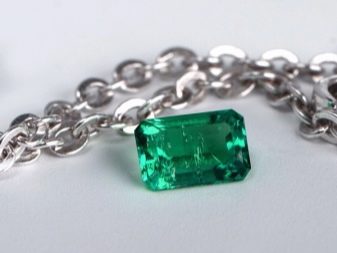
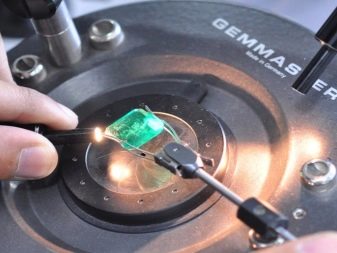
Glass
Glass fakes are significantly inferior in quality to other products, although qualitatively faceted specimens may have an expressive color. Natural emeralds began to be replaced with copies of this available material back in the Middle Ages. In those days, the quality of fakes left much to be desired. Later, glass products were significantly transformed thanks to the work of Venetian craftsmen. Despite their efforts, such fakes were not widely used.
To date, a special beryl glass is brewed for the manufacture of artificial crystals. To obtain the necessary color, chrome is added to it. Only a professional jeweler can determine a fake by eye.
Green bottle glass is also used to create simulations. A small piece of material is processed and inserted into the jewelry.


See how to distinguish natural emerald from artificial emerald in the next video.
